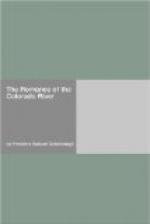Brown’s Park, originally called Brown’s Hole, after one of the early trappers, is a fine valley about 35 miles long and 5 or 6 miles wide. It is, like the few other valleys, an expansion of the canyon walls. There is considerable arable land, and the place possesses a remarkable climate. Though its general level is so high, around 5500 feet, it receives hardly any snow, and for this reason was long a favourite place for wintering cattle on the drive from Texas to California. It was a great rendezvous, also, for the early trappers and traders, and here stood Fort Davy Crockett, in those days famous. It was one of those necessary places of refuge and meeting, established when the trappers were pursuing their extermination of the beaver, which once were so numerous in all the Western country. The river enters this park from the solitudes of Red Canyon, a splendid chasm, 25 miles long, 2500 feet deep, and abounding in plunging waters. The name is from the colour of the sandstone walls. Above it are three short canyons, Kingfisher, Horseshoe, and Flaming Gorge, aggregating about 10 miles. There are there no rapids worth mentioning, but the scenic beauty is entrancing. The walls are from 1200 to 1600 feet, in places extremely precipitous. Flaming Gorge, with walls 1300 feet, is particularly distinguished by being the beginning of the long series of close canyons. The river enters suddenly from Green River Valley, repeating on a smaller scale the conditions at the entrance to Lodore. From here on up to the Wind River Range the stream is flanked by occasional cliffs and buttes, but the country is comparatively open, and the many tributaries often have fine grassy bottoms. This was the locality of the great rendezvous of the period from 1825 to 1835, and even later.
Green River Valley is an elevated region, from six thousand to seven thousand feet above sea. It stretches from the Wind River Mountains on the north to the Uintas on the south, and is bounded westwardly by the Wyoming Range, and on the east merges into the Laramie Plains. The drainage exit is through the Uintas, as noted, by means of the canyons heading at Flaming Gorge. There are here opportunities for extensive farming by irrigation. The only other chance for agriculture on the river, except Wonsits Valley, Brown’s Park, and a few minor places, is below Black Canyon, in the stretches I have called the alluvial and the canyon-valley divisions. In the latter short canyons separate extensive valleys with wide alluvial bottoms capable of high cultivation, though often subject to overflow. Almost anything will grow there. Vast groves of cottonwood and mesquite exist. In the alluvial division, the last stretch of the river, from the Gila down, cotton and sugar cane would probably grow. This is the only division where the water of the river can be extensively diverted. At the mouth of the Gila an old emigrant road to California crossed, and another here in this




